What in the world did i just come across?
#76
Check over on austrotary, there's a few experiments going on with similar tubular cores.
Very neat, I like the compact design........but its really not all that new. PWR barrel water-to-air's have been around for a while, these just take the design and make it more compact.
I'd like to try a water to air setup though, and I like the idea of tubular or barrel style vs. a standard IC basically mounted inside a water tank. Mush less space occupied.
I'm curious though on any rules of thumb for radiator sizing on these though?
Very neat, I like the compact design........but its really not all that new. PWR barrel water-to-air's have been around for a while, these just take the design and make it more compact.
I'd like to try a water to air setup though, and I like the idea of tubular or barrel style vs. a standard IC basically mounted inside a water tank. Mush less space occupied.
I'm curious though on any rules of thumb for radiator sizing on these though?
#77
I've always like water-to-air intercoolers. These intercoolers really proved themselves when Mercedes started using them on their PRODUCTION AMG forced-induction cars around 2004. The leader was Kleeman in 2002-2003. They sandwiched the intercooler between the supercharger and intake manifold and used a dedicated electric pump and heat-exchanger in FRONT of the the stock radiator.
Be sure to check out these threads, esp. on the PWR setup back in the UK:
https://www.rx7club.com/showpost.php...46&postcount=1
More pics here:
http://www.zen44871.zen.co.uk/Pictures/W2AInstall/
:-) neil
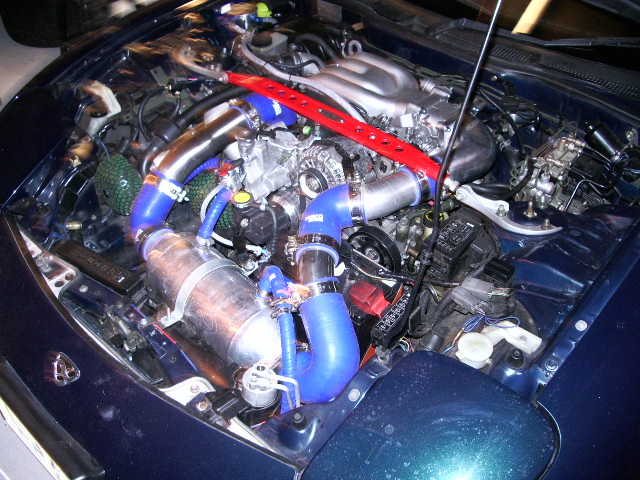
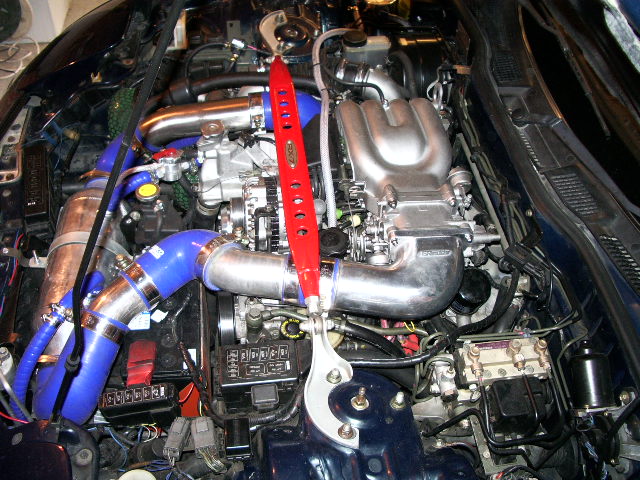
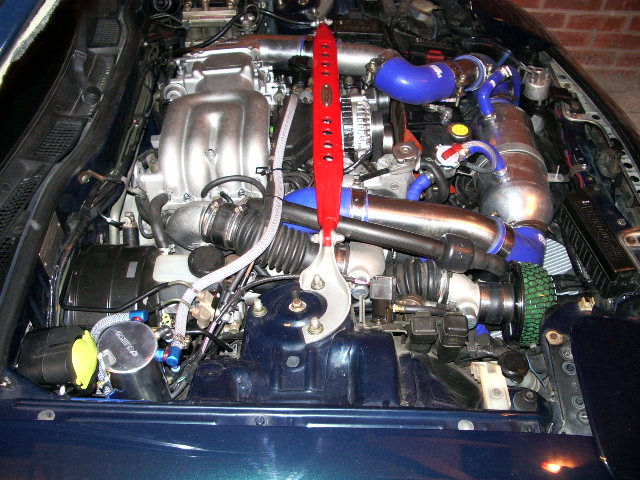
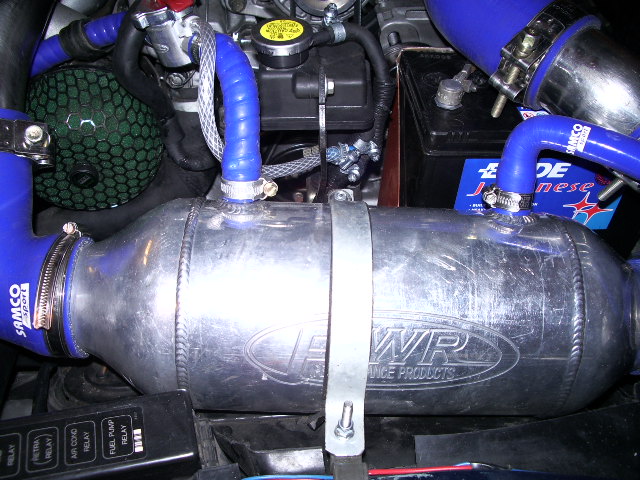
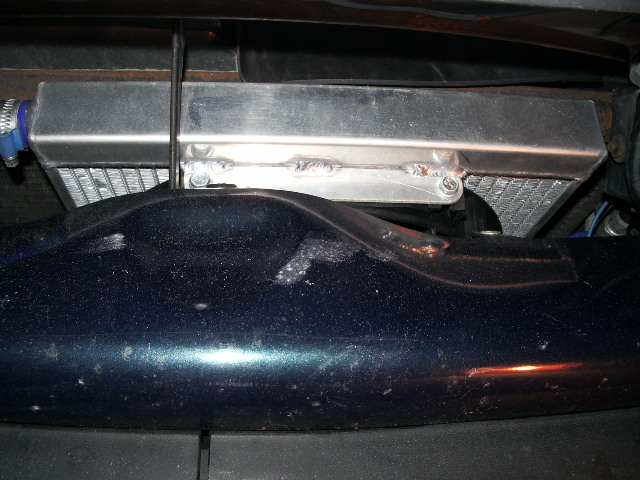

Be sure to check out these threads, esp. on the PWR setup back in the UK:
https://www.rx7club.com/showpost.php...46&postcount=1
More pics here:
http://www.zen44871.zen.co.uk/Pictures/W2AInstall/
:-) neil






#78
New FDguy
iTrader: (2)
Join Date: Dec 2006
Location: Canada
Posts: 176
Likes: 0
Received 0 Likes
on
0 Posts
so I have been looking at couple of sources all day in regards to water-air intercoolers.
As to if air-water intercoolers are good is based upon a few factors.
Advantage of air-water system is that you can
1)place the cooler anywhere, and pump the fluid to the radiator, basically why it's popular with MR, RR crowd.
2) it's more compact, and used less space,
3) has a much smaller pressure drop, need less piping in the system > must increase throttle response right?
4) can make ice water system, below ambient temps!! (drag people)
5) can reach high efficiencies
Advantage of Air-air over air-h20
1) if you can get enough air flow through A/A IC, then the A/A is more efficient, faster you go the more air, the cooler the intercooler
2)A/A is pumpless, and don't need to monitor water
In my opinion, A/A system works well enough if you have good ventilation and air going to the intercooler. Second thing is that a air/water system might have a slight disadvantage when sufficient air is present. heat exchange is based upon temperature differentials. the greater the difference the greater faster heat will be transfered. Because water has a high heat capacity, the water will be cooler than the boost charge. This mean the rad will be less efficient as the water temp to outside air temp differential is smaller... after typing this out, realistically, there is no way except ice water or spraying the Intercooler to get lower than ambient air temps...hmmm... makes you wonder.. anyways here is some readings, I have to get this info sorted in my head...
Both these faqs make conclusions about w/air and air/air IC setups, but don't take their word if it doesn't make sense to you.
Link to faq from water-air intercooling company
http://www.frozenboost.com/stpg.php?...fe76ba0410698a
link to faq from both air-air and h2o-air company
As to if air-water intercoolers are good is based upon a few factors.
Advantage of air-water system is that you can
1)place the cooler anywhere, and pump the fluid to the radiator, basically why it's popular with MR, RR crowd.
2) it's more compact, and used less space,
3) has a much smaller pressure drop, need less piping in the system > must increase throttle response right?
4) can make ice water system, below ambient temps!! (drag people)
5) can reach high efficiencies
Advantage of Air-air over air-h20
1) if you can get enough air flow through A/A IC, then the A/A is more efficient, faster you go the more air, the cooler the intercooler
2)A/A is pumpless, and don't need to monitor water
In my opinion, A/A system works well enough if you have good ventilation and air going to the intercooler. Second thing is that a air/water system might have a slight disadvantage when sufficient air is present. heat exchange is based upon temperature differentials. the greater the difference the greater faster heat will be transfered. Because water has a high heat capacity, the water will be cooler than the boost charge. This mean the rad will be less efficient as the water temp to outside air temp differential is smaller... after typing this out, realistically, there is no way except ice water or spraying the Intercooler to get lower than ambient air temps...hmmm... makes you wonder.. anyways here is some readings, I have to get this info sorted in my head...
Both these faqs make conclusions about w/air and air/air IC setups, but don't take their word if it doesn't make sense to you.
Link to faq from water-air intercooling company
http://www.frozenboost.com/stpg.php?...fe76ba0410698a
link to faq from both air-air and h2o-air company
#80
I think you are over thinking some theory. It is very possible that coolant dissipates heat faster when moving faster, granted that you are moving through an endless cooler.
What I mean is, it isn't the speed of the coolant where my problem was , my problem was based on how long the coolant was held in the radiator. To change how long I needed to keep the fluid in the radiator for proper dissipation I had to change the speed as a solution.
otherwise your statement would make multi pass radiators useless since it makes what you are saying sound like you want the fluid to move in and out of the radiator as fast as possible. If you want to cool off a piece of metal you want it to sit in some water for a a bit, you don't want to just quickly dunk it and remove it, it will still be hot.
#81
Racecar - Formula 2000
I think you are over thinking some theory. It is very possible that coolant dissipates heat faster when moving faster, granted that you are moving through an endless cooler.
What I mean is, it isn't the speed of the coolant where my problem was , my problem was based on how long the coolant was held in the radiator. To change how long I needed to keep the fluid in the radiator for proper dissipation I had to change the speed as a solution.
otherwise your statement would make multi pass radiators useless since it makes what you are saying sound like you want the fluid to move in and out of the radiator as fast as possible. If you want to cool off a piece of metal you want it to sit in some water for a a bit, you don't want to just quickly dunk it and remove it, it will still be hot.
What I mean is, it isn't the speed of the coolant where my problem was , my problem was based on how long the coolant was held in the radiator. To change how long I needed to keep the fluid in the radiator for proper dissipation I had to change the speed as a solution.
otherwise your statement would make multi pass radiators useless since it makes what you are saying sound like you want the fluid to move in and out of the radiator as fast as possible. If you want to cool off a piece of metal you want it to sit in some water for a a bit, you don't want to just quickly dunk it and remove it, it will still be hot.
The flaw in your metal part analogy is that cooling in the case of a radiator and engine is a continuous process. There is always (once the thermostat opens) cooled coolant entering the engine and heated coolant entering the radiator. There is nothing about faster flow that would make a multi-pass radiator less efficient. As a matter of fact, since, due to flowing faster, the coolant would be at a higher temperature later in its flow path through the radiator, it would transfer MORE heat to the radiator and its fins, not less. A similar scenario exists in the engine - since the coolant is moving faster, the coolant at the engine exit would be cooler and able to better absorb the engine heat. The critical item in efficient cooling is how much heat can you transfer, not how many degrees have you heated or cooled the coolant.
To make an analogy to your piece of metal, we would have to remove the water completely from the engine and radiator - that would obviously not work very well.
As you infer, all information obtained either by theory or by experimental studies of heat transfer systems says faster flow, everything else remaining equal, is measurably more efficient.
The "slower flow is better" theory originated when someone noticed that a restriction, slowing flow, at the block exit aided cooling. The reason it worked was not the slower flow. What caused the cooling to improve was creating higher pressure in the block, minimizing hot spots and localized boiling.
Please understand that I am not trying to be an obstinate jerk here. And, I really do not like to be confrontational and argue. I am just trying to refute old wive's tales about cooling. For the benefit of those who may take information on this forum seriously, I don't want mis-information to stand uncorrected.
Dave
#82
Rotary Enthusiast
iTrader: (1)
Join Date: Jan 2008
Location: Austin, TX
Posts: 762
Likes: 0
Received 0 Likes
on
0 Posts
I agree. You do want a fast flow. The heat exchangers ability to cool is constant, but once the water hits what is called "turbulent flow", it is able to shed heat much more effectively.
Generally, you want larger pipes with minimal and smooth bends to reduce pressure drop and also hold a higher volume of water. Then you want a bad *** pump to push all that water quickly. Again, you need to make sure the system has no bad choke points (heat exchanger, S2W core, or poorly designed plumbing).
There is a custom Mr2 set-up with large plumbing, smooth bends, and a powerful pump that cools ridiculously well. I think he is flowing at a rate of 20+ GPM!
Here is a link. Although not an Rx7, that doesn't matter, he is cooling an intake charge. And a lot of thought and work went into this project. Check it out:
http://mr2oc.com/showthread.php?t=250533
Generally, you want larger pipes with minimal and smooth bends to reduce pressure drop and also hold a higher volume of water. Then you want a bad *** pump to push all that water quickly. Again, you need to make sure the system has no bad choke points (heat exchanger, S2W core, or poorly designed plumbing).
There is a custom Mr2 set-up with large plumbing, smooth bends, and a powerful pump that cools ridiculously well. I think he is flowing at a rate of 20+ GPM!
Here is a link. Although not an Rx7, that doesn't matter, he is cooling an intake charge. And a lot of thought and work went into this project. Check it out:
http://mr2oc.com/showthread.php?t=250533
#83
160.000km 10a
Join Date: Sep 2008
Location: australia
Posts: 26
Likes: 0
Received 0 Likes
on
0 Posts
Has any body checked out the coolers by permacool on the lindsayracing web site as well the twelve pass coolers look bad *** and i think would work fantastic in a water to air set up
#84
Junior Member
Join Date: Feb 2009
Location: Bay Area, California
Posts: 24
Likes: 0
Received 0 Likes
on
0 Posts
http://www.opcon.se/index.asp?sPage=1&langID=2&cID=15
The "real deal" in liquid to air intercoolers... These are usually used on superchargers but work well with any form of forced induction. They are used on the Ford GT40
The "real deal" in liquid to air intercoolers... These are usually used on superchargers but work well with any form of forced induction. They are used on the Ford GT40

#85
Please understand that I am not trying to be an obstinate jerk here. And, I really do not like to be confrontational and argue. I am just trying to refute old wive's tales about cooling. For the benefit of those who may take information on this forum seriously, I don't want mis-information to stand uncorrected.
Dave
#86
Racecar - Formula 2000
Remember that the engine (or intercooler in this case) will always be at a higher temperature than the radiator, so there will always be a temperature difference between the coolant and the surfaces it is transferring heat to or from.
Dave
#88
Racecar - Formula 2000
#90
160.000km 10a
Join Date: Sep 2008
Location: australia
Posts: 26
Likes: 0
Received 0 Likes
on
0 Posts
ok how well would this work instead of a water to air intercooler im thinking of an oil cooler using the large cooler tube.
just mod the ends and conect the oil lines from the engine and conect the tube water in to the cold side of the radiator and the out line to the hot side of the radiator.
i think this would be a good idea it should cool enough to work and would allso be very compact and i think preasure drop would be minor.
I t could be mounter some where out of the way as well.
just mod the ends and conect the oil lines from the engine and conect the tube water in to the cold side of the radiator and the out line to the hot side of the radiator.
i think this would be a good idea it should cool enough to work and would allso be very compact and i think preasure drop would be minor.
I t could be mounter some where out of the way as well.
#91
Senior Member
Join Date: Nov 2006
Location: Dallas TX
Posts: 731
Likes: 0
Received 0 Likes
on
0 Posts
http://www.opcon.se/index.asp?sPage=1&langID=2&cID=15
The "real deal" in liquid to air intercoolers... These are usually used on superchargers but work well with any form of forced induction. They are used on the Ford GT40
The "real deal" in liquid to air intercoolers... These are usually used on superchargers but work well with any form of forced induction. They are used on the Ford GT40


#92
First time for me looking at this thread. I did read thru all of it. Maybe I have missed something.
That being said, it appears to me that this tube won't cool very well because it is simply too short. The pressurized air won't stay in there long enough to be cooled very much. Its much the same principle of the stock intercooler being too small.
It's not the same principle as flow thru a radiator where the same water will be continuously recirculating thru the system, keeping a stable temperature. This system will be taking on new hot air that has not been cooled.
I won't be getting one.
That being said, it appears to me that this tube won't cool very well because it is simply too short. The pressurized air won't stay in there long enough to be cooled very much. Its much the same principle of the stock intercooler being too small.
It's not the same principle as flow thru a radiator where the same water will be continuously recirculating thru the system, keeping a stable temperature. This system will be taking on new hot air that has not been cooled.
I won't be getting one.
#94
First time for me looking at this thread. I did read thru all of it. Maybe I have missed something.
That being said, it appears to me that this tube won't cool very well because it is simply too short. The pressurized air won't stay in there long enough to be cooled very much. Its much the same principle of the stock intercooler being too small.
It's not the same principle as flow thru a radiator where the same water will be continuously recirculating thru the system, keeping a stable temperature. This system will be taking on new hot air that has not been cooled.
I won't be getting one.
That being said, it appears to me that this tube won't cool very well because it is simply too short. The pressurized air won't stay in there long enough to be cooled very much. Its much the same principle of the stock intercooler being too small.
It's not the same principle as flow thru a radiator where the same water will be continuously recirculating thru the system, keeping a stable temperature. This system will be taking on new hot air that has not been cooled.
I won't be getting one.
I like the packaging of this system. It would have went perfectly with my last setup. Pity.
#96
Last year, I came across this product while researching on A2W configurations.
The question left unanswered by Lindsey was the the thermal efficiency of these units.
That cooled me off - also had to put my project aside for other reasons.
FYI, below is the link to last year thread. There is some more discussion on heat transfer design, lack of turbulence, etc. that qualitative point to possibly relative low thermal efficiency.
https://www.rx7club.com/rotary-car-performance-77/air-water-ic-lindsey-racing-thp-616516/
If you have or can find/obtain from Lindsey some more structured efficiency data, that would be very useful.
- Sandro
The question left unanswered by Lindsey was the the thermal efficiency of these units.
That cooled me off - also had to put my project aside for other reasons.
FYI, below is the link to last year thread. There is some more discussion on heat transfer design, lack of turbulence, etc. that qualitative point to possibly relative low thermal efficiency.
https://www.rx7club.com/rotary-car-performance-77/air-water-ic-lindsey-racing-thp-616516/
If you have or can find/obtain from Lindsey some more structured efficiency data, that would be very useful.
- Sandro
#97
I dont think Lindsay would go to all the work if it didn't yield results. Your claim for it not having enough time could be proven/disproven with a simple inlet/outlet temperature log. I would bet that data is available at some of the Porsche boards where these coolers have been used more extensively.
I like the packaging of this system. It would have went perfectly with my last setup. Pity.
I like the packaging of this system. It would have went perfectly with my last setup. Pity.
#98
Water is just a little more dense than air and as such can take just a little more heat out of the air per unit surface area of the cooling fins. Just because you don't see it, doesn't lend any evidence to your argument of why it can't work. Air/water intercoolers have worked for a long time and as mentioned previously are being used on factory supercharged cars such as those from AMG.
Like I said before. A simple before cooler/after cooler, intake temp sensor log could solve the efficiency argument....and I am sure the data is out there on the Porsche boards, since that is who Lindsay mainly markets to.
Like I said before. A simple before cooler/after cooler, intake temp sensor log could solve the efficiency argument....and I am sure the data is out there on the Porsche boards, since that is who Lindsay mainly markets to.
#99
Full Member
Join Date: Jan 2002
Location: Oshkosh, WI
Posts: 54
Likes: 0
Received 0 Likes
on
0 Posts
Something to consider regarding the length: Looking at the quantity of internal fins and their shape I would guess there is a lot more turbulence. This would explain how these work even though they are relatively short.
I'm planning on trying one as well, but only after I can talk to someone who has actually used one. My plan was to run water lines next to the fuel rail in an attempt to locate the heat exchanger somewhere in the rear. I like trying new things and generally fabricate my own components where I can so these sort of projects always fascinate me!
I work for mercury marine and have dealt with these systems at racing. We have an infinite supply of cold lakewater which helps. We see outstanding performance with extremly small air-to-water systems. Ours our flat though so it cannot be directly compared since there is little heat transfer from fin to fin via air flow
I'm planning on trying one as well, but only after I can talk to someone who has actually used one. My plan was to run water lines next to the fuel rail in an attempt to locate the heat exchanger somewhere in the rear. I like trying new things and generally fabricate my own components where I can so these sort of projects always fascinate me!
I work for mercury marine and have dealt with these systems at racing. We have an infinite supply of cold lakewater which helps. We see outstanding performance with extremly small air-to-water systems. Ours our flat though so it cannot be directly compared since there is little heat transfer from fin to fin via air flow
#100
Full Member
Join Date: Jan 2002
Location: Oshkosh, WI
Posts: 54
Likes: 0
Received 0 Likes
on
0 Posts
I just talked to Dave at Lindsey Racing. He says they don't have any additional data they are willing to share but they are setting up some dyno testing this Spring and will make inlet and outlet temps available for the air and the coolant. Kind of sucks they wont share anything but maybe down the road the test cars can be compared to similar cars with air-to-air setups.


 Heck, I am an old-timer - 66 as of last October!
Heck, I am an old-timer - 66 as of last October!